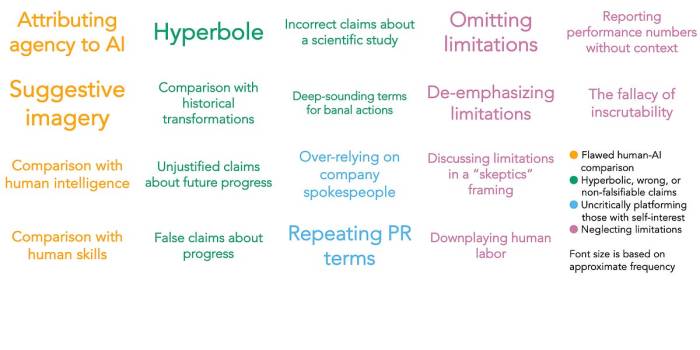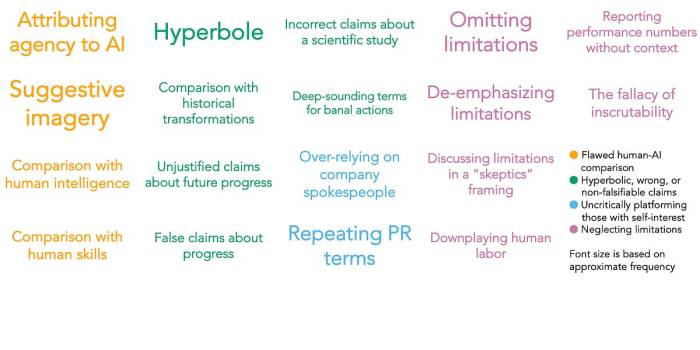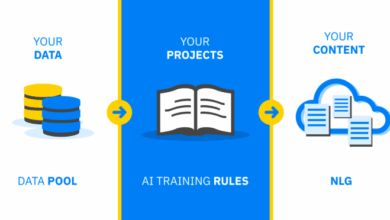
Pitfalls to avoid when communicating about AI: Navigating the complexities of artificial intelligence requires careful consideration. Misunderstandings, oversimplifications, and a lack of context can easily lead to miscommunication and a skewed public perception of this rapidly evolving field. This exploration dives deep into the common pitfalls to avoid, offering practical strategies for clear and effective communication about AI.
From the technical jargon to the ethical concerns, this post highlights key areas where communication about AI can falter. Understanding these potential stumbling blocks will empower individuals and organizations to craft more accurate and accessible narratives about AI’s capabilities, limitations, and implications. The result? A more informed and nuanced public discourse that promotes understanding and trust.
Misunderstandings about AI Capabilities
Artificial intelligence is rapidly transforming our world, but its capabilities are often misunderstood. This can lead to unrealistic expectations and miscommunication about what AI can and cannot do. It’s crucial to understand the true potential and limitations of AI to harness its benefits effectively. This section explores common misconceptions surrounding AI’s abilities.AI is frequently portrayed as a sentient entity capable of independent thought and decision-making, often exceeding human intelligence.
However, this portrayal is frequently inaccurate and can lead to significant misinterpretations. The reality is more nuanced. Understanding these common misconceptions is key to fostering informed discussions about AI’s role in society.
Common Misconceptions about AI’s Abilities
AI systems are frequently portrayed as having superhuman cognitive abilities, which often leads to inaccurate expectations. It’s vital to differentiate between the capabilities of current AI systems and the aspirational portrayals found in science fiction.
- AI is capable of general intelligence and independent thought.
- Current AI systems are capable of understanding context and nuance in human language to the same degree as humans.
- AI can solve complex problems without explicit instructions or pre-programmed data.
- AI is unbiased and objective in its decision-making.
- AI can learn and adapt without human intervention.
These misconceptions often lead to inflated expectations and disappointment when AI systems fail to meet these idealized standards. It’s important to acknowledge the limitations of current AI technology and focus on its practical applications within specific domains.
Avoiding hype and overly-optimistic pronouncements is key when discussing AI. It’s easy to get caught up in the buzz surrounding the technology, but focusing on realistic applications and potential pitfalls is crucial. For instance, a recent documentary on Vitalik Buterin’s involvement in crypto and Ukraine, crypto ukraine vitalik buterin documentary , highlights the complexities of emerging technologies and the importance of responsible communication.
Ultimately, clear, grounded explanations are vital to avoid misinterpretations and unrealistic expectations regarding AI’s future.
AI Capabilities vs. Misconceptions
The following table contrasts genuine AI capabilities with common misconceptions to highlight the critical distinctions:
| Genuine AI Capabilities | Common Misconceptions | Explanation |
|---|---|---|
| AI excels at pattern recognition and prediction in specific domains, like image classification or fraud detection. | AI possesses general intelligence comparable to or exceeding human intelligence. | AI excels in tasks where it has been trained on vast amounts of data, but its ability to generalize outside of its training data remains limited. |
| AI can perform complex calculations and data analysis at speeds far exceeding human capabilities. | AI can solve complex problems without explicit programming or pre-existing data. | AI algorithms are trained on existing data, so they rely on patterns and relationships learned from the input data. |
| AI systems can automate repetitive tasks, increasing efficiency in many sectors. | AI is capable of independent thought and decision-making in complex situations. | AI systems require human oversight and guidance, especially in critical decision-making processes. |
| AI is adept at generating text, images, and other forms of creative content based on existing patterns. | AI possesses human-level understanding and creativity. | AI generates content based on patterns learned from vast datasets, not true understanding or creativity. |
| AI systems can be trained to perform specific tasks, like playing chess or translating languages. | AI can learn and adapt without any human intervention. | AI systems require extensive training data and ongoing fine-tuning, and are limited by their programming and training datasets. |
Oversimplification and Hype
The allure of artificial intelligence often leads to oversimplification and hype, obscuring the true capabilities and limitations of these systems. This oversimplification can lead to unrealistic expectations, hindering responsible development and deployment. Understanding the nuances of AI is crucial to avoid both unwarranted optimism and undue fear.
Dangers of Oversimplification
Oversimplifying complex AI concepts can lead to a misrepresentation of their potential and capabilities. This can result in misplaced faith in AI solutions for problems they are not equipped to handle, or, conversely, an unwarranted fear of AI’s capabilities. It’s crucial to recognize that AI systems are not inherently good or bad; their impact depends heavily on how they are designed, deployed, and regulated.
It’s easy to get sidetracked when talking about AI, especially when discussing complex ethical issues. For example, it’s crucial to avoid sensationalizing the potential impact of AI, especially when discussing events like International Women’s Day in Iran, and the plight of activists like Narges Mohammadi, who is nominated for the Nobel Peace Prize. This important news story highlights the urgent need for responsible AI development, and we should be careful not to let our enthusiasm for AI overshadow important human rights issues.
Instead, focus on balanced, nuanced discussions about AI’s role in society, without losing sight of the real-world consequences.
Common Overstatements and Exaggerations, Pitfalls to avoid when communicating about ai
Many AI discussions fall prey to overstatements and exaggerations. Claims of AI achieving general intelligence or mimicking human creativity often lack substantial evidence. It’s essential to differentiate between demonstrable progress and unsubstantiated promises. For example, while AI can excel at specific tasks, it typically lacks the broader understanding and adaptability that defines human intelligence. Similarly, while AI can generate creative outputs, these outputs are usually based on patterns and data from existing content rather than true originality.
AI Applications and Limitations
A crucial step in navigating the AI landscape is understanding the limitations of specific applications. While AI is rapidly advancing, its capabilities are not universal. The following table illustrates some common AI applications and their limitations, aiming to avoid hype and foster a more realistic perspective.
| AI Application | Capabilities | Limitations |
|---|---|---|
| Image Recognition | Can accurately identify objects and patterns in images with high precision, especially in well-defined datasets. | Struggles with ambiguous images, subtle changes, or images outside the training data. Requires significant training data and can be easily fooled by manipulated images. |
| Natural Language Processing (NLP) | Can process and generate human language with impressive fluency, answering questions and summarizing text. | Lacks true understanding of context and nuance, leading to factual errors or inappropriate responses. Can be biased by the data it’s trained on. |
| Machine Translation | Can translate between languages with reasonable accuracy for general purposes. | May struggle with idioms, cultural references, and nuanced language. Accuracy can vary greatly depending on the language pair. |
| Robotics | Can perform complex tasks with precision in controlled environments. | Has difficulty adapting to unpredictable situations or unexpected obstacles. Highly dependent on pre-programmed routines. |
| Fraud Detection | Can analyze large datasets to identify patterns indicative of fraudulent activities. | Requires continuous monitoring and adaptation to evolving fraud tactics. May inadvertently flag legitimate transactions. |
Lack of Context and Background

AI’s rapid advancement often overshadows the critical need for a nuanced understanding of its development and limitations. Without proper context, discussions about AI can easily become superficial, leading to misinterpretations and unfounded anxieties or unrealistic expectations. A historical perspective reveals the gradual progress and iterative nature of AI, providing a crucial foundation for evaluating its present capabilities and potential future trajectories.Understanding AI requires more than just its current capabilities.
It necessitates an appreciation for the underlying principles, the historical context of its evolution, and the ethical considerations that accompany its development and deployment. This understanding allows for a more balanced and informed dialogue, steering clear of the pitfalls of hype and misinformation.
Importance of Providing Context
Contextualizing AI discussions is paramount for several reasons. Firstly, it prevents oversimplification by situating AI within its historical and theoretical framework. Secondly, it allows for a more nuanced evaluation of AI’s strengths and weaknesses, avoiding the pitfalls of either glorifying or demonizing its capabilities. Thirdly, contextualization facilitates a more informed discussion of the ethical implications, fostering responsible innovation and use of this powerful technology.
Significance of Historical Context in AI Development
AI is not a sudden invention but a culmination of decades of research and development. Understanding this historical context is vital for comprehending the current state of AI and anticipating its future. Early attempts at creating “thinking machines” often faced significant limitations, highlighting the complexities inherent in mimicking human intelligence. The evolution from rule-based systems to neural networks illustrates the incremental progress and the constant adaptation of approaches.
Essential Background Information for AI Communication
To communicate effectively about AI, certain background information is crucial. Providing a historical overview, outlining the key milestones in AI development, is essential for demonstrating its incremental progress and limitations. Explaining the different types of AI (e.g., narrow vs. general AI) clarifies the specific capabilities of existing systems and the challenges of achieving broader intelligence. Furthermore, defining key concepts, such as machine learning, deep learning, and natural language processing, ensures a common understanding for all participants.
- Historical Overview: Tracing the history of AI, from early symbolic AI to modern machine learning, reveals the gradual development and the challenges faced. This overview highlights the iterative nature of progress and helps to demystify the technology.
- Types of AI: Distinguishing between narrow (task-specific) and general AI clarifies the capabilities of existing systems and the ongoing quest for broader intelligence. This understanding prevents overstating the current capabilities of AI.
- Key Concepts: Defining terms like machine learning, deep learning, natural language processing, and others is essential for establishing a shared vocabulary. This ensures clarity and avoids ambiguity in discussions.
- Ethical Considerations: Acknowledging the ethical implications of AI, including bias, privacy, and job displacement, promotes responsible development and use. This proactive discussion avoids potentially harmful consequences.
- Limitations of Current AI: Acknowledging that current AI systems are not perfect and often struggle with tasks requiring common sense or nuanced understanding is crucial for realistic expectations. This prevents the creation of unrealistic expectations and fosters responsible innovation.
Technical Jargon and Complexity
AI is rapidly evolving, and its underlying technical concepts can be daunting for a broad audience. This often leads to confusion and misinterpretations. To effectively communicate about AI, it’s crucial to avoid overly technical language and tailor the explanation to the audience’s understanding.Overusing complex terminology can create a barrier to understanding, potentially alienating those who could benefit most from AI knowledge.
Clear, concise, and accessible language fosters trust and allows for meaningful engagement.
Avoiding Overly Technical Language
Effective communication about AI requires a conscious effort to simplify technical jargon. This approach not only enhances comprehension but also promotes a more inclusive and accessible understanding of AI. It’s about presenting complex ideas in a way that resonates with a diverse audience.
Examples of Confusing Technical Terms
Several technical terms can easily confuse non-technical audiences. These terms, while essential to the field, can obscure the core concepts for those unfamiliar with the terminology. Examples include:* Backpropagation: A complex algorithm used in neural networks.
Gradient Descent
A method for optimizing the parameters of a model.
Convolutional Neural Networks (CNNs)
A specialized type of neural network used for image processing.
Natural Language Processing (NLP)
A branch of AI dealing with human language.
Reinforcement Learning
A machine learning technique where an agent learns by interacting with an environment.These terms, while crucial in the AI field, can be quite abstract and difficult for someone without a background in computer science to grasp.
Simplified Explanations and Alternatives
A clear way to bridge the gap between technical and non-technical communication is through simplified explanations and appropriate alternatives. The table below illustrates this process.
| Technical Term | Simplified Explanation | Alternative Term/Phrase |
|---|---|---|
| Backpropagation | A method for adjusting the settings of a model to improve its accuracy based on the results of its predictions. | Fine-tuning the model |
| Gradient Descent | A way to find the best settings for a model by gradually making small adjustments to get closer to the desired outcome. | Optimizing the model’s settings |
| Convolutional Neural Networks (CNNs) | A type of AI that’s especially good at understanding images, recognizing patterns, and identifying objects. | AI for image recognition |
| Natural Language Processing (NLP) | AI that allows computers to understand and respond to human language. | AI that understands and responds to human speech |
| Reinforcement Learning | A way for AI to learn by trying things out, getting feedback, and adjusting its actions accordingly. | Learning through trial and error |
Using alternative phrases or providing simple explanations helps the audience understand the underlying concept behind the technical terms, making the discussion more accessible and engaging.
Emotional Responses and Bias
The rapid advancement of AI has sparked a range of emotional responses, from excitement and hope to fear and distrust. These emotional reactions can significantly impact how we engage with and understand AI, often clouding rational discourse and hindering productive discussions about its potential and implications. Understanding the interplay between emotions and biases is crucial to fostering informed and balanced conversations about this transformative technology.The presence of inherent biases in data used to train AI models can lead to skewed outcomes and perpetuate existing societal prejudices.
This can manifest in unfair or discriminatory AI systems, reinforcing harmful stereotypes and exacerbating existing inequalities. These biases are not always easily detectable, and require careful scrutiny and responsible development practices to mitigate.
Emotional Responses to AI
Emotional responses to AI often stem from a combination of factors, including perceived threat to jobs, anxieties about the unknown, and the general societal impact of a rapidly evolving technology. Fear of the unknown is a natural human response, and this can manifest in various forms, from concern about job displacement to worries about AI’s potential misuse. A critical understanding of these emotional reactions is essential for fostering productive dialogue.
- Fear and Anxiety: The rapid pace of AI development can trigger fear and anxiety about job displacement, societal control, and unforeseen consequences. This emotional response can impede rational discussion and lead to unproductive reactions. For instance, fears about autonomous vehicles replacing human drivers can lead to resistance to their adoption, even if the long-term benefits are apparent.
- Excitement and Enthusiasm: The potential of AI to solve complex problems and improve various aspects of human life can evoke feelings of excitement and enthusiasm. While this is a positive emotion, it can also lead to unrealistic expectations and oversimplification of the technology’s capabilities.
- Distrust and Skepticism: Concerns about data privacy, algorithmic transparency, and potential misuse of AI can generate distrust and skepticism. This emotional response can hinder the development of trust and cooperation necessary for responsible AI development and implementation.
Impact of Biases on AI Communication
AI systems trained on biased data can perpetuate and amplify existing societal biases. This can lead to unfair or discriminatory outcomes in areas such as loan applications, criminal justice, and hiring processes. Understanding the potential for bias in AI systems is crucial for responsible development and implementation.
- Reinforcement of Stereotypes: If an AI system is trained on data that reflects existing societal stereotypes, it can reinforce these stereotypes in its outputs and perpetuate harmful prejudices.
- Unfair Outcomes: Bias in AI can lead to unfair or discriminatory outcomes, particularly in areas like loan applications, criminal justice, and hiring processes. This can have serious consequences for individuals and communities.
- Algorithmic Discrimination: Algorithmic discrimination refers to the unfair or discriminatory outcomes that can result from the use of AI systems that are biased or have not been properly tested for bias. This can manifest in various forms, such as unequal access to resources or opportunities.
Methods for Mitigating Emotional Responses
Addressing emotional responses to AI requires a multifaceted approach. Transparency, education, and open dialogue are crucial to fostering understanding and trust.
- Promoting Transparency and Explainability: Making AI systems more transparent and explainable can help build trust and reduce anxieties. Understanding how AI systems arrive at their decisions can help address concerns about fairness and bias.
- Providing Comprehensive Education: Educating the public about AI, its capabilities, and its limitations can help manage unrealistic expectations and promote a more nuanced understanding of the technology. This education should focus on both the potential benefits and risks of AI.
- Encouraging Open Dialogue and Discussion: Facilitating open and honest discussions about AI’s impact on society can help address concerns and fears while promoting collaboration and responsible development.
Inadequate Explanations of AI Processes
AI systems, while powerful, often operate in ways that are opaque to the average person. This lack of transparency can lead to distrust and hinder adoption. Understanding how these systems work, even in simplified terms, is crucial for building trust and fostering responsible development and deployment. This is where clear and accessible explanations of AI processes become vital.Effective communication about AI requires more than just presenting the end result.
It demands a breakdown of the underlying mechanisms, allowing individuals to grasp the decision-making processes, identify potential biases, and assess the reliability of the outcomes. By demystifying these processes, we empower users to engage with AI in a more informed and confident manner.
Simplifying Complex Technical Procedures
Explaining complex technical procedures involved in AI requires a strategic approach. Instead of overwhelming the audience with technical jargon, focus on conveying the core concepts using analogies and relatable examples. This approach allows the audience to connect with the subject matter on a deeper level, facilitating comprehension and retention. Consider using visualizations, flowcharts, or simple diagrams to illustrate the process.
Analogies can be particularly effective, transforming abstract concepts into tangible, relatable scenarios. For example, comparing a machine learning algorithm to a student learning from examples, or a recommendation system to a librarian recommending books.
Steps for Explaining AI Processes Clearly and Concisely
Effective explanation of AI processes necessitates a structured approach. Following these steps can lead to clear and concise communication:
- Identify the target audience: Understanding the background knowledge and technical literacy of your audience is paramount. Tailor your explanation to resonate with their level of understanding. A technical explanation to a non-technical audience will be quite different from a technical explanation to another technical audience.
- Focus on the core concepts: Avoid getting bogged down in the minutiae of the technical details. Highlight the essential steps and processes that drive the AI system’s output. Instead of focusing on the complex mathematical calculations, emphasize the overall flow of the process.
- Use relatable analogies and examples: Transform abstract concepts into relatable scenarios. Relatable analogies and examples help audiences connect with the subject matter on a deeper level, facilitating comprehension and retention. A clear and straightforward example of a process will be much more memorable than a long technical description.
- Visual aids: Visualizations, flowcharts, and simple diagrams significantly enhance comprehension. These aids illustrate the process in a clear and concise manner, making abstract concepts more tangible and easier to grasp.
- Iterative feedback: Solicit feedback from your audience to assess the effectiveness of your explanation. Are they able to grasp the key concepts? Do they have any questions or concerns? Adjust your explanations based on the feedback to improve clarity and comprehension.
Examples of Effective Explanations
A good example of a simplified explanation would be describing a facial recognition system. Instead of delving into the intricate details of convolutional neural networks, focus on the process: capturing an image, extracting facial features, comparing those features to a database of known faces, and identifying a match. This simplified explanation effectively communicates the core function without overwhelming the audience with technical jargon.
Failure to Address Ethical Concerns: Pitfalls To Avoid When Communicating About Ai
The rapid advancement of artificial intelligence (AI) necessitates a careful consideration of its ethical implications. Ignoring these concerns can lead to unforeseen and potentially harmful consequences, ranging from biased decision-making to the erosion of human rights. Proactive engagement with ethical dilemmas is crucial to ensure responsible AI development and deployment.AI systems, when not carefully designed and monitored, can perpetuate and amplify existing societal biases.
Furthermore, the lack of transparency in some AI algorithms can make it difficult to understand how decisions are made, raising concerns about accountability and fairness. Addressing ethical considerations is not merely an add-on but an integral part of the AI development lifecycle.
Ethical Dilemmas in AI
Ethical dilemmas surrounding AI are multifaceted and arise across various application domains. Examples include algorithmic bias in loan applications, perpetuating discriminatory outcomes against specific demographics. Another example involves the use of AI in criminal justice, potentially leading to inaccurate assessments of risk or biased sentencing. Autonomous weapons systems present a profound ethical challenge, raising questions about accountability and the potential for unintended escalation of conflict.
These are just a few instances highlighting the urgent need for careful ethical evaluation of AI.
Potential Ethical Implications of Different AI Applications
| AI Application | Potential Ethical Implications |
|---|---|
| Autonomous Vehicles | Potential for accidents due to unforeseen circumstances, liability issues in case of accidents, ethical dilemmas in prioritizing safety of different parties in an accident (pedestrians, passengers, other drivers). |
| AI in Healthcare | Bias in diagnostic tools, privacy concerns regarding patient data, accountability issues regarding misdiagnosis or treatment failure, access to advanced medical technologies based on affordability and location. |
| AI in Recruitment | Bias in candidate selection, perpetuation of existing inequalities in the workforce, lack of transparency in the decision-making process, and potentially discriminatory outcomes. |
| AI in Criminal Justice | Bias in risk assessments and sentencing, lack of transparency in algorithms, potential for misjudgments and wrongful convictions, and the potential for increased surveillance and monitoring. |
| AI in Financial Services | Bias in loan applications and credit scoring, potential for financial exploitation and discrimination, and the vulnerability of financial systems to malicious attacks. |
Ignoring User Feedback and Concerns

Ignoring user feedback and concerns when communicating about AI can lead to misaligned expectations, decreased adoption, and ultimately, a less effective and impactful implementation. Active listening and addressing user concerns are crucial for building trust and ensuring AI solutions meet real-world needs. This section will explore the importance of user feedback and practical strategies for gathering and responding to concerns about AI.
The Importance of Active Listening
User feedback provides invaluable insights into how people perceive and interact with AI. By actively listening to their concerns, developers and communicators can identify potential pitfalls in their messaging and tailor their approach to resonate with diverse audiences. Understanding user anxieties, misconceptions, and expectations is critical for effective AI deployment and acceptance.
Strategies for Gathering User Concerns
A variety of methods can be employed to gather user feedback and address concerns about AI. Surveys, focus groups, and online forums are effective ways to solicit feedback from a wider range of users. Direct engagement with users through feedback forms on AI products or services can also provide valuable input. Monitoring social media conversations and online discussions about AI can help identify emerging concerns and trends in public perception.
Avoiding overly technical jargon is key when discussing AI, especially when speaking to a wider audience. The recent Booz Allen CEO Horacio Rozanski interview, available here , highlights the importance of clear and concise communication. Ultimately, framing AI in relatable terms, focusing on practical applications, and avoiding hype are crucial to effective communication about this rapidly evolving field.
Creating a Feedback Mechanism for AI-Related Communication
Developing a structured feedback mechanism is essential for ongoing communication about AI. This mechanism should be accessible, easy to use, and incentivize participation. A dedicated email address, online forum, or even a social media hashtag can serve as a central point for users to voice their concerns and provide feedback. Regular surveys, using clear and concise questions, can help gather data on user perceptions and experiences.
Prompt and thoughtful responses to user feedback are vital to demonstrate that concerns are taken seriously and addressed appropriately. These responses should be tailored to the specific concern raised.
- Establish clear channels: Provide multiple avenues for feedback, including email, online forms, social media, and dedicated phone lines. Each channel should have clear guidelines for submitting feedback, ensuring users understand how their input will be processed.
- Create a dedicated feedback team: Designate a team or individual responsible for collecting, analyzing, and responding to user feedback. This team should be trained to address concerns constructively and professionally. This team should ensure prompt responses and acknowledgements to each user’s feedback.
- Analyze and categorize feedback: Develop a system for categorizing user feedback to identify recurring themes and patterns. This allows for targeted improvements in AI communication and development. Analyze feedback to identify common threads, such as concerns about privacy, bias, or job displacement.
- Develop action plans based on feedback: Use the gathered feedback to inform decisions regarding AI development, deployment, and communication. Action plans should detail the steps taken to address each concern, and timelines for implementation should be established. Tracking the progress of addressing each feedback item is crucial.
Insufficient Transparency
AI systems, especially complex ones, can be shrouded in mystery. This lack of transparency can lead to distrust and hinder public acceptance. Understanding how AI arrives at its conclusions is crucial for building confidence and ensuring responsible development and deployment. Without clear explanations, users may perceive AI as a “black box,” fostering fear and skepticism.
The Value of Transparency in AI Communication
Transparency in AI communication builds trust and fosters understanding. When AI systems are open and explainable, users can gain confidence in their reliability and accuracy. This transparency also allows for easier identification and mitigation of potential biases or errors. Openness about data sources, algorithms, and decision-making processes empowers users to critically evaluate the AI’s output and potentially identify and rectify any issues.
Crucially, transparency facilitates accountability, allowing stakeholders to understand how AI systems are used and who is responsible for their actions.
Examples of How Lack of Transparency Can Harm Trust
A lack of transparency can severely damage public trust in AI. Imagine a loan application system that denies a loan applicant without providing any explanation. Without knowing the reasoning behind the denial, the applicant might feel unfairly treated, leading to a loss of trust in the system and potentially sparking legal challenges. Similarly, an autonomous vehicle’s decision to avoid a pedestrian without a clear explanation could lead to public concern and skepticism about its safety and reliability.
In healthcare, an AI diagnosis without an explanation of the reasoning could lead to a patient’s distrust in the system, hindering its adoption. These scenarios highlight how a lack of transparency can breed suspicion and erode public confidence.
Comparing Transparent and Opaque Approaches to AI Communication
| Feature | Transparent Approach | Opaque Approach |
|---|---|---|
| Data Sources | Clearly defined and accessible data sources, allowing users to understand the information used to train the AI. | Data sources hidden or not clearly articulated, making it difficult to assess the AI’s training data and potential biases. |
| Algorithm Details | Clear description of the algorithm used, including its structure and logic. | Algorithm details kept confidential, making it hard to understand how the AI system arrives at its conclusions. |
| Decision-Making Process | Explainable decision-making process, allowing users to understand the steps taken by the AI. | Decision-making process not explained, creating a “black box” effect. |
| Potential Biases | Identification and mitigation of potential biases in the system are clearly articulated. | Potential biases are not discussed, making it hard to identify or mitigate issues. |
| Error Handling | Clear mechanisms for handling errors, allowing users to understand the AI’s limitations. | Errors are not explained or addressed, potentially leading to inaccurate or harmful results. |
| User Impact | Clear communication about the potential impact of the AI on users. | Potential impact on users is not disclosed, potentially leading to negative consequences. |
Ignoring Cultural Differences
AI’s impact transcends geographical boundaries, but its communication and application must consider diverse cultural contexts. Failing to acknowledge these differences can lead to misinterpretations, resistance, and ultimately, hinder the widespread adoption and benefits of AI. Understanding cultural nuances is crucial for fostering trust and ensuring that AI systems are truly beneficial for all.
Cultural Variations in AI Perceptions
Different cultures hold varying perspectives on automation, technology, and the role of human intervention. Some cultures may embrace technological advancement readily, while others might be more cautious or resistant. Trust in institutions and authorities also plays a significant role. In some cultures, a strong emphasis on human interaction and personal relationships can affect how people perceive AI-driven interactions.
For example, in cultures prioritizing direct communication, AI systems might need to adapt their interaction style to be more explicit and less ambiguous, whereas in cultures valuing indirect communication, a more subtle approach could be more effective.
Cultural Considerations for Effective AI Communication
Effective AI communication requires a deep understanding of cultural norms, values, and expectations. These considerations are essential to prevent misinterpretations and ensure the adoption of AI is beneficial for everyone.
- Language and Communication Styles: AI systems should be designed to accommodate various languages and communication styles. This includes understanding cultural preferences for direct versus indirect communication, and formal versus informal language use. Different languages have different ways of expressing concepts, and direct translation can sometimes lead to unintended meanings.
- Cultural Values and Beliefs: AI systems should be designed to respect cultural values and beliefs. For instance, certain cultures may have strong traditions regarding privacy or data protection. AI systems should be designed to accommodate these cultural sensitivities.
- Historical and Societal Context: Understanding the historical and societal context of different cultures is crucial. This includes understanding past experiences with technology, societal norms, and the potential for cultural biases to be reflected in AI systems. For example, historical mistrust of government institutions in a particular culture could influence how people perceive AI systems designed and implemented by these institutions.
- Local Expertise and Feedback: Incorporating local expertise and feedback is essential to ensure AI systems are relevant and beneficial to diverse communities. This includes seeking input from community leaders, cultural experts, and individuals from various backgrounds.
- Accessibility and Inclusivity: AI systems should be accessible to everyone, regardless of their cultural background. This includes considering factors such as language barriers, literacy levels, and digital literacy. Ensuring equitable access to AI technology is crucial for its widespread adoption and positive impact on all cultures.
Summary
In conclusion, effective communication about AI demands a multifaceted approach. By acknowledging and addressing potential pitfalls—from clarifying capabilities to acknowledging ethical concerns—we can foster a more productive and insightful conversation about this transformative technology. By prioritizing clarity, context, and empathy, we pave the way for a future where AI is understood, embraced, and utilized responsibly.





